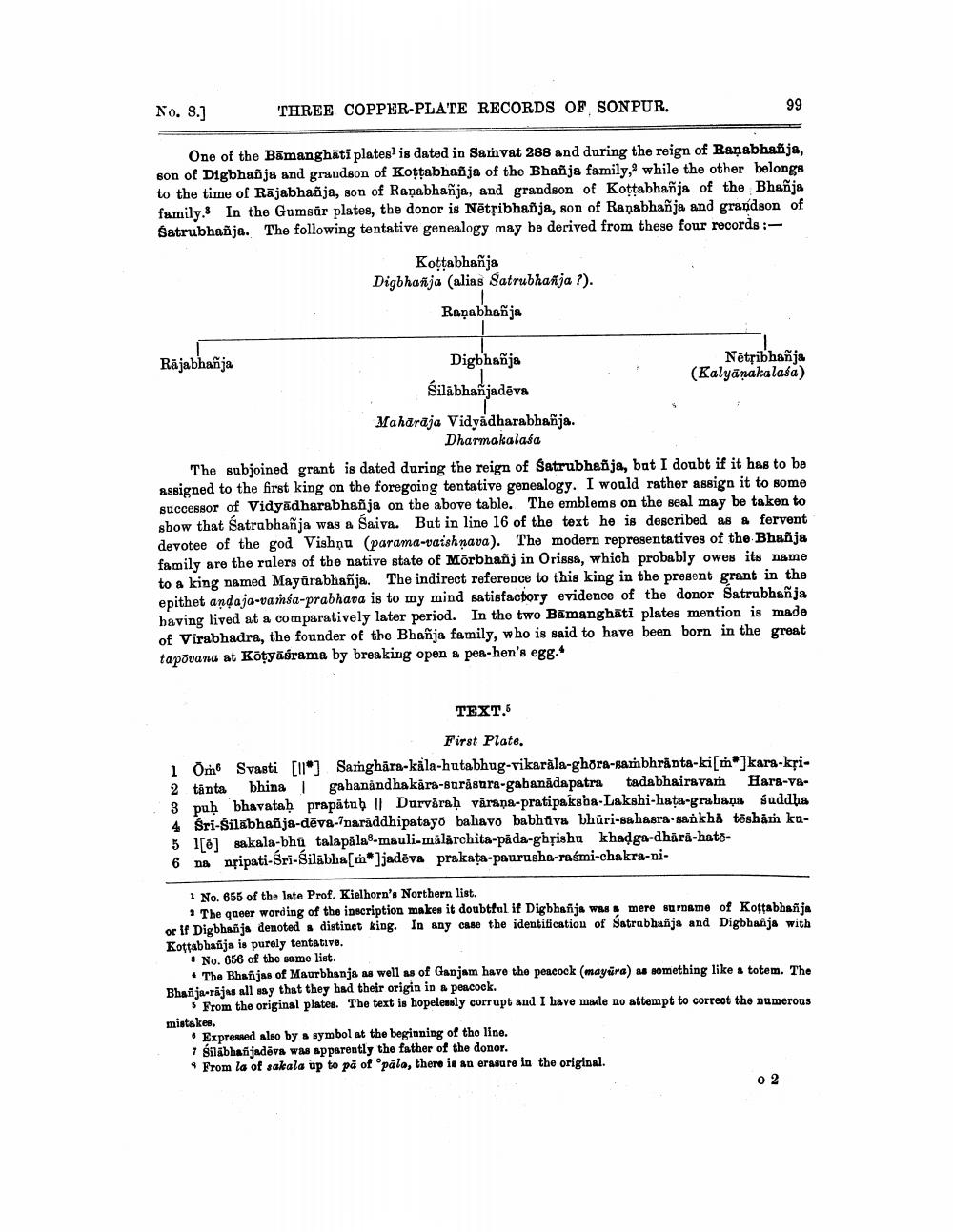________________
No. 8.]
THREE COPPER-PLATE RECORDS OF SONPUR.
One of the Bāmanghāti plates is dated in Samvat 288 and during the reign of Ranabhañja, son of Digbhañja and grandson of Kottabhañja of the Bhanja family, while the other belongs to the time of Rājabhañja, son of Ranabhanja, and grandson of Kottabhañja of the Bhañja family. In the Gumsúr plates, the donor is Nētribhanja, son of Ranabhañja and grandson of Satrubhañja. The following tentative genealogy may be derived from these four records :
Kottabhañja Digbhañja (alias Satrubhanja ?).
Rapabhañja
Rajabhañja
Digbhañja
Nētsibhañja
(Kalyānakalasa) siläbhańjadēva Mahārāja Vidyadharabhañja.
Dharmakalasa The subjoined grant is dated during the reign of Satrubhañja, bat I doubt if it has to be assigned to the first king on the foregoing tentative genealogy. I would rather assign it to some successor of Vidyadharabhañja on the above table. The emblems on the seal may be taken to show that Satrabhanja was a Saiva. But in line 16 of the text he is described as a fervent devotee of the god Vishnu (parama-vaishnava). The modern representatives of the Bhañja family are the rulers of the native state of Mörbhanj in Orissa, which probably owes its name to a king named Mayarabhañja. The indirect reference to this king in the present grant in the epithet andaja-varéa-prabhava is to my mind satisfactory evidence of the donor Satrubhañja having lived at a comparatively later period. In the two Bamanghati plates mention is made of Virabhadra, the founder of the Bhañja family, who is said to have been born in the great tapovana at Kötyäsrama by breaking open a pea-hen's egg.*
TEXT.5
First Plate. i Om Svasti [11] Sarghāra-kila-hutabhug-vikarāla-ghora-sambhränta-bi[m]kara-ksi2 tanta bhinal gahanandhakara-barastra-gabanādapatra tadabhairavam Hara-va3 puh bhavataḥ prapātub Il Durvåraḥ vårana-pratipaksha Lakshi-hata-grahans saddha 4 Sri-Silabhanja-dēva-naraddhipatayo bahavo babhäva bhüri-bahasra-sankhả töshåm ku5 1[0] sakala-bha talapāla 8-mauli-mälärchita-pada-ghțishu khadga-dhära-hate6 na npipati-Sri-Silābha[m*]jaděva prakata-paurusha-rasmi-chakra-ni
1 No. 655 of the late Prof. Kielhorn's Northern list.
? The queer wording of the inscription makes it doubtful if Digbhanja was mere surname of Kottabhalja or if Digbhañja denoted distinct king. In any case the identification of Satrubhusja and Digbhanja with Kottabbañijs is purely tentative.
* No. 656 of the same list.
+ The Bhafijas of Maurbhanja as well as of Ganjam have the peacock (mayūra) as something like a totem. The Bhaja-rijns all say that they had their origin in peacock.
From the original plates. The text is hopelessly corrupt and I have made no attempt to correct the pumerous mistakes.
• Expressed also by a symbol at the beginning of tho line. 7 silabhañjadēva was apparently the father of the donor. From la of sakala up to på of "pāla, there is an erasure in the original.
0 2




